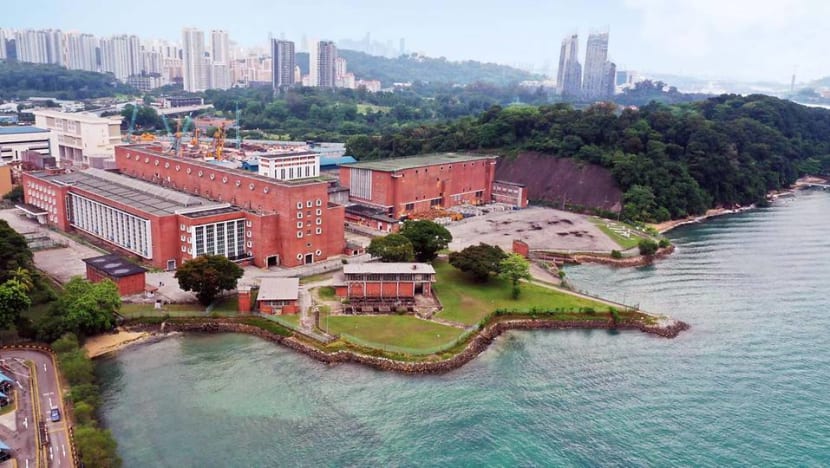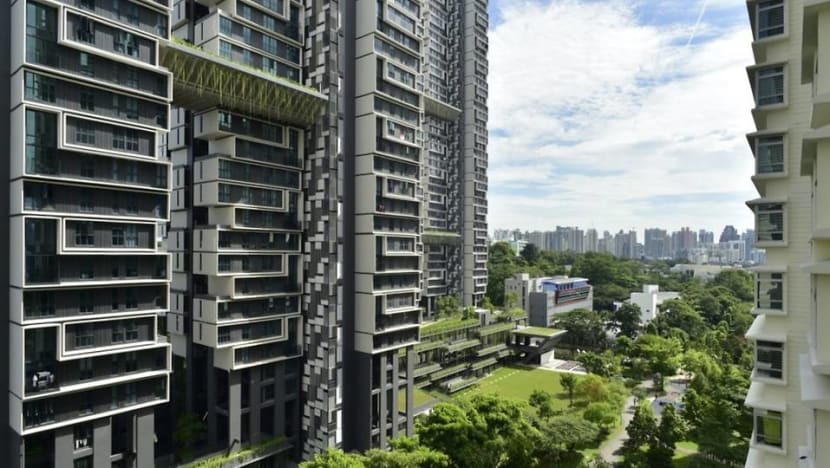commentary Commentary
Commentary: When Singapore homes become workspaces – huge changes in the house and beyond
Big changes in the home, residential estates and the Central Business District are underway, say Kwok Tian Long and Sing Tien Foo.

A general view shows newly occupied Housing Development Board (HDB) public residential flats in Singapore on Mar 5, 2018. (File photo: AFP/Roslan Rahman)
SINGAPORE: The butterfly effect is the idea that small changes, like a butterfly flapping its wings, can catalyse huge changes that have massive ramifications for complex systems.
Since Singapore entered DORSCON Orange in February, work began its long migration into homes, with split team arrangements implemented by firms as a preventive measure to mitigate the spread of the disease.
And after the circuit breaker was imposed in April, work-from-home (WFH) became a default mode for work, alongside home-based learning for schools.
Many corporate leaders and tech giants like Apple, Facebook, Microsoft and Google will allow staff to work remotely until early 2021 when chances of a vaccine being developed and distributed are higher. A handful, like Twitter, have even gone further to extend WFH arrangements to staff indefinitely.
READ: Government working towards Phase 3, but Singapore will remain in DORSCON Orange ‘for the time being’: Gan Kim Yong
READ: Commentary: Singapore’s almost in our new normal. Don’t be the dud who jeopardises that
WORK IS MOVING AWAY FROM THE OFFICE
Those butterfly effects have been felt immediately in Singapore’s once vibrant Central Business District.
Some offices have emptied since the circuit breaker when white-collar workers and executives were mandated to stay home.
Despite Education Minister and Multi-ministry taskforce co-chair Lawrence Wong urging companies to let workers return to the office on Sep 24, working remotely from home has become a new normal and will persist in a post COVID-19 world, even if only for a few days a week.
This go against decades-long trend of agglomeration, where face-to-face interactions fuelled collaboration, learning and innovation, leading over time to the high concentration of firms in high-rise skyscrapers in city centres around the world and feeding sky-high rents in those districts.

Yet, overnight, work decentralised into homes, aided by video-conferencing platforms and communications technologies, like Zoom, Webex and Teamviewer.
Another leap was made when the necessity of remote working paved the way for a change in mindsets in employers who experienced first-hand productivity gains.
"I don't fear any slowness as we work to distribute our workforce now, and I do think we have to build a company that's not entirely dependent on San Francisco," Twitter CEO Jack Dorsey said.
LISTEN: Returning to the office – can you say no?
READ: Commentary: I’ve been career oriented my whole life, until the COVID-19 pandemic took my ambition
FIRMS MAY MOVE AWAY FROM THE CBD
In Singapore, the idea of a distributed workforce is not new, and somewhat aligned with the Urban Redevelopment Authority’s strategy since its groundbreaking Concept Plan of 1991 to set up regional centres in Jurong East, Woodlands and Tampines to move offices out of the congested city centre and closer to residential estates.
There have been successes in getting corporates to shift out prior to COVID-19. Google moved its local headquarters out from Asia Square 1 to the city fringe into Mapletree Business City 2 in 2016.
If more firms relook their WFH policy and review the need for big office spaces in the CBD, this decentralisation could cool demand there and even hasten the exodus of firms from the city centre, leaving behind excess building space.
READ: Work in office, from home, or both? Hybrid work has potential and pitfalls, say experts
READ: Commentary: Singapore’s CBD needs to redevelop to stay relevant in a post-COVID world
While owners of older buildings, such as AXA tower and International Plaza, may be pressured to convert these to mixed-use developments and take advantage of URA’s CBD Incentive Scheme, the current economic downturn due to COVID-19 may delay such redevelopment plans.
But in the longer term, these trends underway will unleash a new wave of changes in the urban structure of CBD, accelerating its reconfiguration, now a predominantly business and financial district, into a more integrated work-live-play place.
Urgent rethinking is needed to realise plans for the 360 ha in the Marina Bay’s downtown and the 2,000 ha in the future Greater Southern Waterfront into this reality. In fact, the planned 20,000 more homes to be added there as part of the 2019 URA Master Plan may even need to be revised upwards.

If so, more schools, social and recreational amenities, and better transport connectivity will be required.
As workers have more WFH days, they may be less willing to pay for expensive housing space in the core central region (CCR).
And if workspaces are distributed more permanently to the outside central region (OCR), price differentials for private houses in OCR and CCR may come down.
READ: Commentary: Why Singapore's private residential market will remain attractive in the long term
LISTEN: COVID-19 and the outlook for Singapore’s residential property market in 2020 and beyond
CHANGES IN THE HOME
The modern Singapore home is not really suited for WFH where homes have been designed for rest, retreat and dining, with little remaining space for work.
According to the Department of Statistics, the average household size for HDB 4-room flat is 3.22 with a typical floor area of 90 sqm - meaning around 28 sqm per person.
This number is lower for families who live in compact shoebox units with a typical floor area of around 50 sqm.
Many have repurposed the dining table for work but even that can be challenging with video calls and home-based learning happening simultaneously.
Separate study areas where each family member can focus on work or school is ideal, beyond bedrooms providing this makeshift segregation. Some households may prefer an additional purpose-built study room.
In retrospect, the 2018 URA guidelines requiring a minimum average unit size of 85 sqm for new developments in OCR and 100 sqm in selected areas, which may have been intended to reduce infrastructure strain in neighbourhoods, now look prescient where they mandate developers to provide larger spaces for residents.
READ: Goodbye office: Is the future of work in our homes?

Residential buildings are less well insulated acoustically to cut off noise. Traffic noise, noisy neighbours, and people movements can pose unhelpful distractions when working from home.
But simple improvements, like ensuring stable and reliable high-speed broadband networks, installing day curtains and setting up a home office space with a comfortable, table, chair and monitor, can vastly improve productivity.
We will also likely see more Singaporeans invest in making their homes work-friendly.
READ: Commentary: How much should young couples spend on their first home?
READ: Commentary: Why do we love judging other people’s home renovations?
US online remodelling platform Houzz reported a 50 per cent surge in leads for home renovations after lockdowns were imposed. People channelled funds usually saved for holidays to remodel home offices, kitchens and undertake other improvement works to make homes more liveable.
MORE MICROBUSINESSES
As more Singaporeans experience income uncertainty and job losses, we may also see more set up their own microenterprises.
While microbusinesses have been allowed to run from homes under the Home Office Scheme (HOS) since 2001, in recognition that home-based entrepreneurship scheme promote the creation of business and entrepreneurship, these have been limited mostly to certain professional services such as consultancy, insurance and financial planning services.
HOS had led to the creation of new businesses by 23 per cent, a 2019 study Professor Sumit Agarwal and two other colleagues found. More may take up the scheme, as an alternative to co-working space providers.
After all, WeWork and JustCo typically charges S$200 to S$500 for a hot desk. Saving on rent can reduce business costs and help a good number of firms survive. Our past research shows firms set up after 2001 that were able to utilise HOS are 29 per cent less likely to exit compared to firms set up before 2001.
READ: With the coronavirus still in our midst, what does the future hold for the workplace?
CHANGES IN NEIGHBOURHOODS
As Singapore residents spend more time at home, neighbourhood shops will see a bigger boost in demand.
While WFH has adversely impacted restaurants, food joints, cafés and pubs in the CBD, where businesses are dependent on office workers, coffee shops, eating houses and supermarkets in residential estates saw an uptick in business.
Food delivery services, such as Panda, Deliveroo, Grab, offering island-wide delivery and providing key lifelines to downtown eateries, have seen a surge in demand.
But our bet is that big brand names, cafes and new-fangled dining concepts may find residential estates more attractive locations for a second outlet.
Despite conventional wisdom that COVID-19 has decimated F&B, nearly 201 new F&B entities have been formed in the three months (June to August) after the reopening of the economy based on Accounting and Corporate Regulatory Authority data.
There was also a net increase of 96 F&B entities in the first half of 2020 alone, which include restaurants, cafes, food caterers, food kiosks and bars, according to data analysis firm Handshakes.
READ: Commentary: Please don’t end work from home. It’s not that bad

More cloud kitchens have popped up near residential estates during COVID-19. Jollibee recently opens its first shared kitchen dedicated to delivery orders at Tampines Smart City.
Some big brand names in retail are also moving into neighbourhood malls. Don Don Donki opened their largest outlet at JEM earlier this year and IKEA is opening a 3-storey outlet in the same mall next year.
As Singapore readies to shift into Phase 3 of our reopening, we may have to adjust and adapt to a new normal that brings “live, work and play” closer to home.
Current land use patterns may undergo significant structural shifts if WFH becomes a default modus operandi for most firms and office workers.
It sounds like a very small change but this butterfly may stir up a storm.
The CNA Leadership Summit 2020: Navigating the Post-Pandemic World will discuss through a series of TV programmes and webinars how businesses and organisations have reacted to the pandemic and applied innovative practices.
More details are available at: cna.asia/leadership-summit.
Kwok Tian Long is Research Associate at the Department of Real Estate (DRE) and Institute of Real Estate and Urban Studies (IREUS), and Professor Sing Tien Foo is the Head of DRE and Director of IREUS at the National University of Singapore.
The views and opinions expressed herein are those of the authors and do not represent the views and opinions of the National University of Singapore or any of its subsidiaries or affiliates.

















